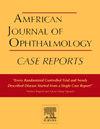眼眶彩色多普勒成像显示黑朦进展为视网膜动脉闭塞伴球后栓塞前移
Q3 Medicine
引用次数: 0
摘要
目的眼眶彩色多普勒成像(CDI)可用于评价突发性单眼视力丧失,提供病因信息,指导治疗。我们提出两例模糊黑朦进展为视网膜动脉闭塞(RAO)与视网膜中央动脉(CRA)内高回声颗粒的迁移和CDI发现的血管动力学改变有关。观察两例患者均表现为隐匿性黑朦,CDI显示视神经头处有2.8 mm高回声颗粒。患者1被发现有严重的主动脉狭窄和胸主动脉瘤,在等待心胸外科手术修复评估的同时,接受了双重抗血小板治疗(DAPT)。10天后,患者1出现中央性RAO,再次CDI显示栓子前移1.0 mm, CRA血流速度降低,电阻率指数增加。患者2接受DAPT和口服皮质类固醇治疗,但在类固醇减量期间症状复发,需要延长类固醇疗程。全身性并发症需要减少类固醇剂量,患者在初次就诊6个月后出现分支RAO。重复CDI显示栓子前移0.9 mm, CRA血流速度和电阻率指数升高。患者2使用组织型纤溶酶原激活剂进行全身溶栓和恢复类固醇治疗并没有导致视力改善。结论和重要性:模糊黑朦时,CDI上CRA可见高回声颗粒,CDI参数的前移可能与栓塞性视网膜缺血的临床进展有关。栓子的显像可以预测对溶栓或抗凝治疗无反应。本文章由计算机程序翻译,如有差异,请以英文原文为准。
Amaurosis fugax progressing to retinal artery occlusion with anterior migration of a retrobulbar embolus on orbital color Doppler imaging
Purpose
Orbital color Doppler imaging (CDI) is useful in the evaluation of sudden monocular vision loss, providing information on etiology which may guide management. We present two cases of amaurosis fugax progressing to retinal artery occlusion (RAO) associated with migration of a hyperechoic particle within the central retinal artery (CRA) and altered vascular dynamics found on CDI.
Observations
Both patients presented with amaurosis fugax, and CDI revealed a hyperechoic particle 2.8 mm from the optic nerve head in both patients. Patient 1 was found to have severe aortic stenosis and a thoracic aortic aneurysm and was managed with dual antiplatelet therapy (DAPT) while awaiting evaluation for cardiothoracic surgical repair. Ten days later, Patient 1 returned with a central RAO, and a repeat CDI showed a 1.0 mm anterior migration of the embolus with reduced CRA blood velocity and an increased resistivity index. Patient 2 was managed with DAPT and oral corticosteroids, but symptoms recurred during steroid tapering which necessitated a prolonged course of steroids. Systemic complications required reduction of steroid dosing, and the patient developed a branch RAO six months after initial presentation. Repeat CDI revealed a 0.9 mm anterior migration of the embolus, with increased CRA blood velocity and resistivity index. Systemic thrombolysis with tissue plasminogen activator and resumption of steroids did not result in visual improvement in Patient 2.
Conclusions and importance
The presence of a hyperechoic particle in the CRA on CDI can be seen with amaurosis fugax, and anterior migration with subsequent alterations in CDI parameters may correlate with clinical progression to embolic retinal ischemia. Visualization of an embolus may predict nonresponse to thrombolytic or anticoagulation-based treatment.
求助全文
通过发布文献求助,成功后即可免费获取论文全文。
去求助
来源期刊

American Journal of Ophthalmology Case Reports
Medicine-Ophthalmology
CiteScore
2.40
自引率
0.00%
发文量
513
审稿时长
16 weeks
期刊介绍:
The American Journal of Ophthalmology Case Reports is a peer-reviewed, scientific publication that welcomes the submission of original, previously unpublished case report manuscripts directed to ophthalmologists and visual science specialists. The cases shall be challenging and stimulating but shall also be presented in an educational format to engage the readers as if they are working alongside with the caring clinician scientists to manage the patients. Submissions shall be clear, concise, and well-documented reports. Brief reports and case series submissions on specific themes are also very welcome.
 求助内容:
求助内容: 应助结果提醒方式:
应助结果提醒方式:


